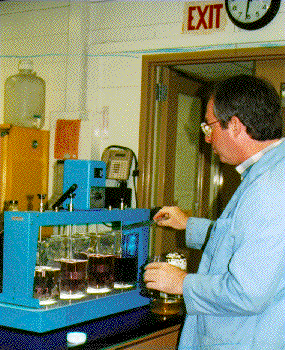by Cathy Ortega Klett, WRRI, with Alison Sawyer, Waste-management Education and Research Consortium
The City of Albuquerque and a number of other U.S. municipalities draw drinking water supplies from groundwater containing elevated levels of arsenic arising in many cases from natural sources.

The current U.S. Environmental Protection Agency (EPA) acceptable threshold limit for arsenic is 50 ppb (parts per billion) and this standard can be met in many cases without special water treatment, often by blending water supplies.
There are new proposals to tighten this standard to 1 ppb, which will result in cities having to either seek new drinking water supplies or remove arsenic from their current supplies. Until recently, there have been no cost-effective water treatment technologies that could remove arsenic at such low concentrations.
Two years ago, Professor Michael Johnson of New Mexico State University’s Chemistry and Biochemistry Department was provided funding through WRRI’s Seed Money Research Program to develop a cost-effective method of removing arsenic from contaminated water supplies.
Dr. Johnson and Robert Wingo, a master’s candidate in environmental chemistry, have developed new chemical procedures using ferrate [iron(VI)] to remove extremely low concentrations of arsenic and arsenic containing compounds from water.
Dr. Johnson’s approach uses ferrate, K 2FeO 4, to simultaneously convert all the forms of arsenic to the arsenate ion and subsequently precipitate it from water as highly insoluble ferric arsenate. This work has proved effective in lowering dissolved arsenic to levels below 1 ppb.
Besides being more cost-effective than “old” methods, this approach has several advantages over previous methods. It reduces the amount of sludge production and there are minimal pretreatment requirements compared to traditional methods.
The ferrate method was not the first technique tried by Johnson. “We started out using chlorine in our initial research, which is inexpensive and easy to handle,” said Johnson. “However, the EPA’s concern about discharging chlorine into the environment made us look at alternative removal techniques.”
Johnson has developed a research partnership in this effort with Lee Ciampi of Pearl Environmental, Wayzata, Minnesota. The collaboration greatly enhances the study because the company is developing new production methods to decrease the cost of ferrate and increase its availability. Because of Johnson’s earlier work, Pearl Environmental became interested in the research on ferrate application. Ferrate had not been commercially available until now, through Pearl Environmental’s efforts.
The project has been supported by several New Mexico entities in addition to the WRRI NMSU’s Waste-management Education and Research Consortium, Los Alamos National Laboratory and others. The research also provides graduate and undergraduate students with a hands-on approach to water quality research and water analysis. NMSU undergraduates Bernie Lorenz, Department of Chemistry and Biochemistry, and Cooper Harrelson, Department of Chemical Engineering, are participating on the project.
The WRRI will publish Dr. Johnson’s research results as part of its technical completion report series this spring.
Michael Johnson, associate professor in chemistry and biochemistry at NMSU, prepares solutions for a series of arsenic studies. Photo by Alison Sawyer.
